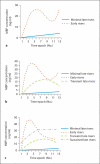Trajectory analysis of serum biomarker concentrations facilitates outcome prediction after pediatric traumatic and hypoxemic brain injury
- PMID: 20847541
- PMCID: PMC3215242
- DOI: 10.1159/000316803
Trajectory analysis of serum biomarker concentrations facilitates outcome prediction after pediatric traumatic and hypoxemic brain injury
Abstract
Traumatic brain injury (TBI) and hypoxic ischemic encephalopathy (HIE) are leading causes of morbidity and mortality in children. Several studies over the past several years have evaluated the use of serum biomarkers to predict outcome after pediatric brain injury. These studies have all used simple point estimates such as initial and peak biomarker concentrations to predict outcome. However, this approach does not recognize patterns of change over time. Trajectory analysis is a type of analysis which can capture variance in biomarker concentrations over time and has been used with success in the social sciences. We used trajectory analysis to evaluate the ability of the serum concentrations of 3 brain-specific biomarkers - S100B, neuron-specific enolase (NSE) and myelin basic protein (MBP) - to predict poor outcome (Glasgow Outcome Scale scores 3-5) after pediatric TBI and HIE. Clinical and biomarker data from 100 children with TBI or HIE were evaluated. For each biomarker, we validated 2-, 3- and 4-group models for outcome prediction, using sensitivity and specificity. For S100B, the 3-group model predicted poor outcome with a sensitivity of 59% and specificity of 100%. For NSE, the 3-group model predicted poor outcome with a sensitivity of 48% and specificity of 98%. For MBP, the 3-group model predicted poor outcome with a sensitivity of 73% and specificity of 61%. Thus, when the models predicted a poor outcome, there was a very high probability of a poor outcome. In contrast, 17% of subjects with a poor outcome were predicted to have a good outcome by all 3 biomarker trajectories. These data suggest that trajectory analysis of biomarker data may provide a useful approach for predicting outcome after pediatric brain injury.
Copyright © 2010 S. Karger AG, Basel.
Figures



References
-
- Ong L, Selladurai BM, Dhillon MK, Atan M, Lye MS. The prognostic value of the Glasgow Coma Scale, hypoxia and computerised tomography in outcome prediction of pediatric head injury. Pediatr Neurosurg. 1996;24:285–291. - PubMed
-
- Grewal M, Sutcliffe AJ. Early prediction of outcome following head injury in children: an assessment of the value of Glasgow Coma Scale score trend and abnormal plantar and pupillary light reflexes. J Pediatr Surg. 1991;26:1161–1163. - PubMed
-
- Feickert HJ, Drommer S, Heyer R. Severe head injury in children: impact of risk factors on outcome. J Trauma. 1999;47:33–38. - PubMed
-
- Carter BG, Butt W. A prospective study of outcome predictors after severe brain injury in children. Intensive Care Med. 2005;31:840–845. - PubMed
-
- Prasad MR, Ewing-Cobbs L, Swank PR, Kramer L. Predictors of outcome following traumatic brain injury in young children. Pediatr Neurosurg. 2002;36:64–74. - PubMed
Publication types
MeSH terms
Substances
Grants and funding
LinkOut - more resources
Full Text Sources
Other Literature Sources
Miscellaneous

